Abstract
Strains of Escherichia coli with sufficient K antigen to resist killing by complement were poorly phagocytosed when injected intravenously into mice. Phagocytosis was markedly increased by anti-OK but not by anti-O sera. In contrast anti-K sera had little or no effect on the bactericidal reaction. This was not because K antigenic sites were scarce but may have been because their position was such that complement was activated at a distance from its substrate. Red cells coated with K antigen were poorly lysed by complement and anti-K serum, suggesting that the K antibody did not activate complement very effectively although again the sites may have been too superficial. The effect of K antigens on phagocytosis and complement killing or lysis could all be explained by their ability to impair protein binding.
Strains of E. coli rich in K antigen were resistant to phagocytosis and complement killing and were virulent for mice on intracerebral injection. The significance of K antigens in animal and human infections is discussed.
Full text
PDF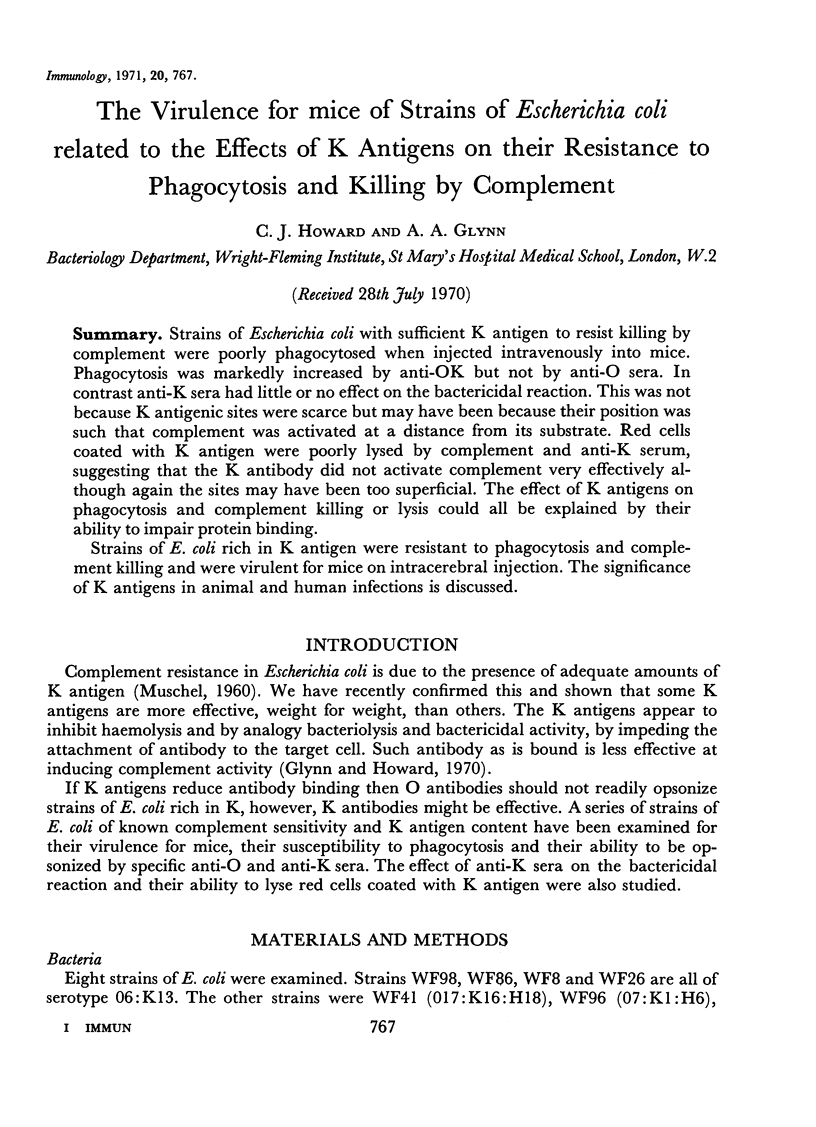
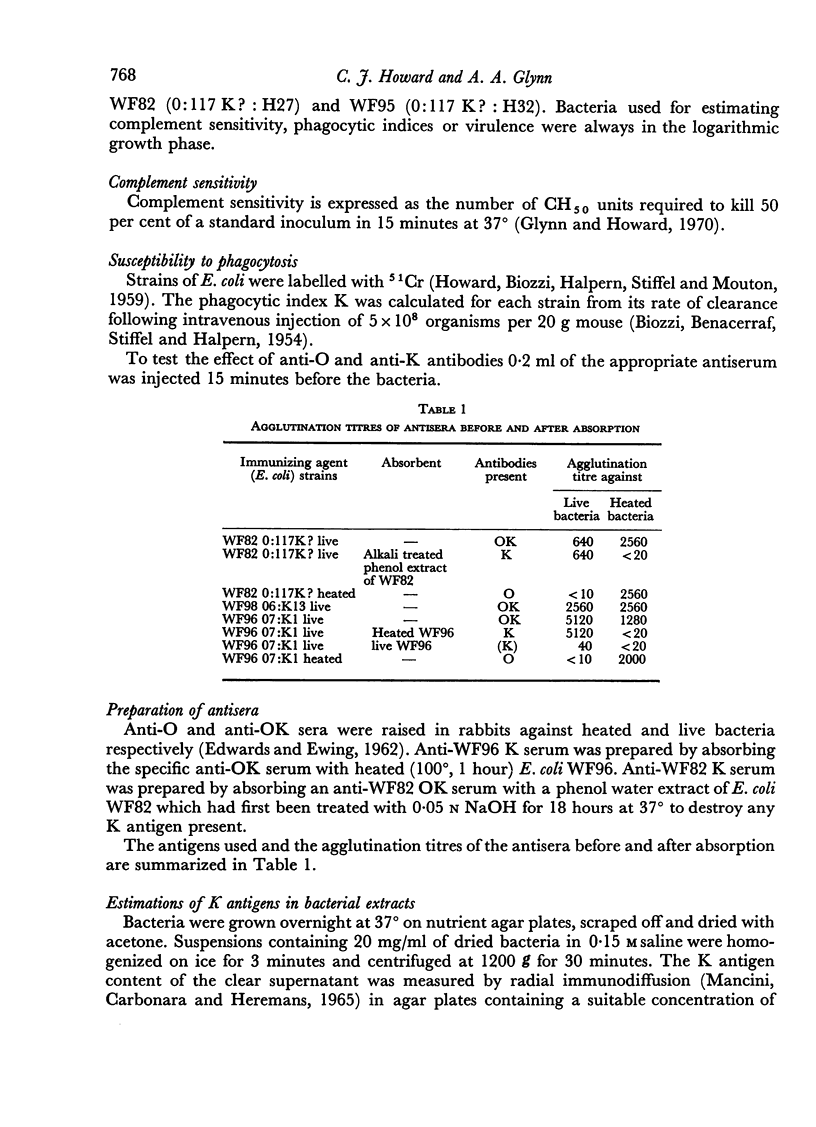
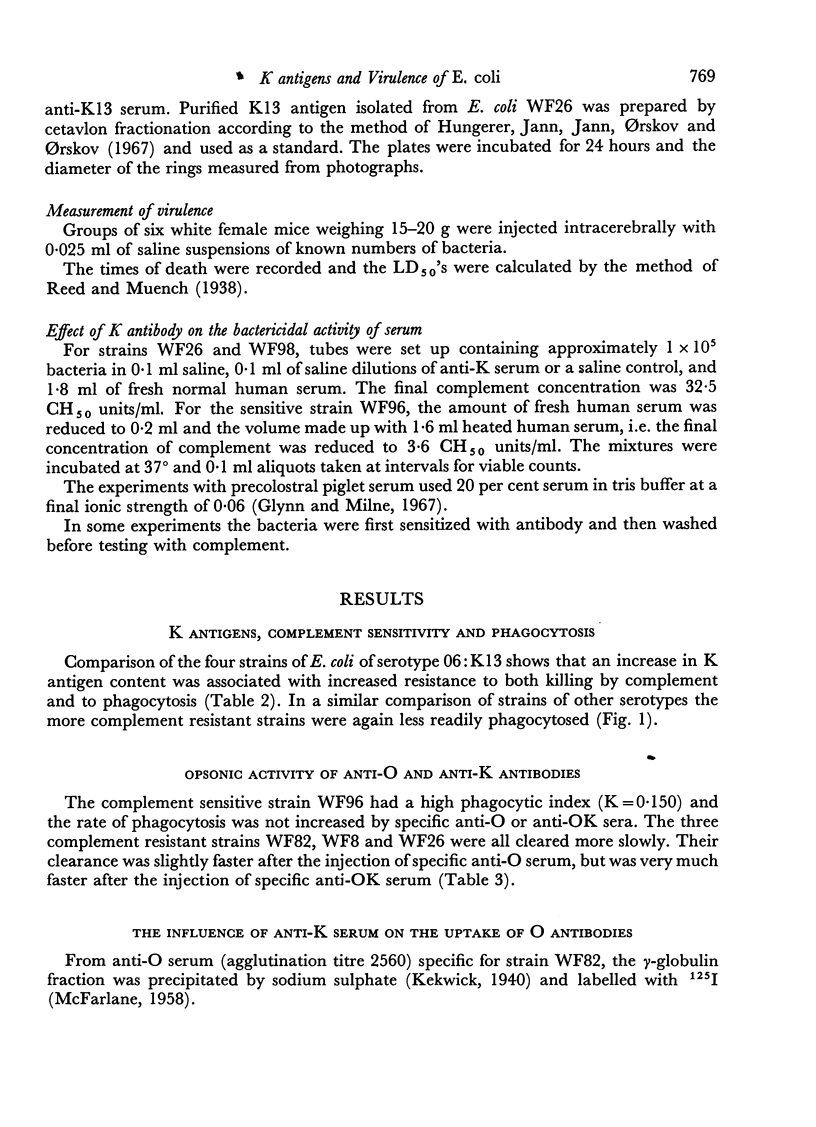
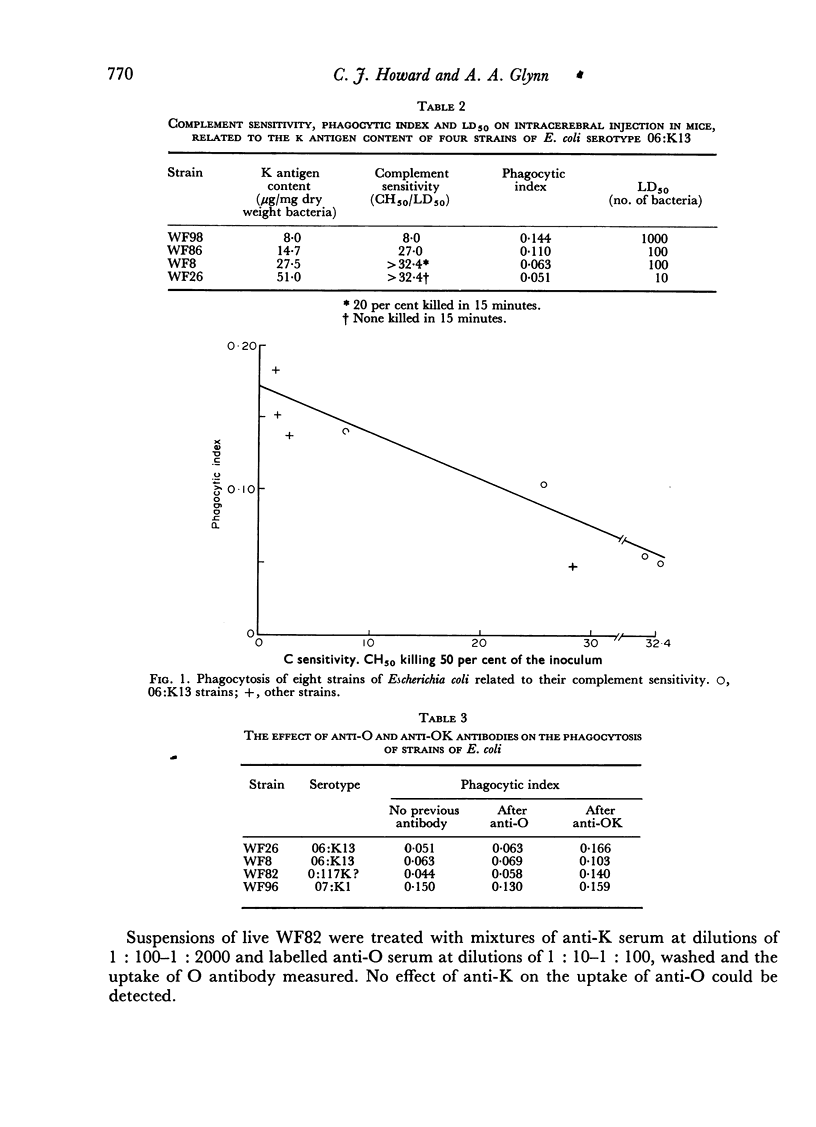
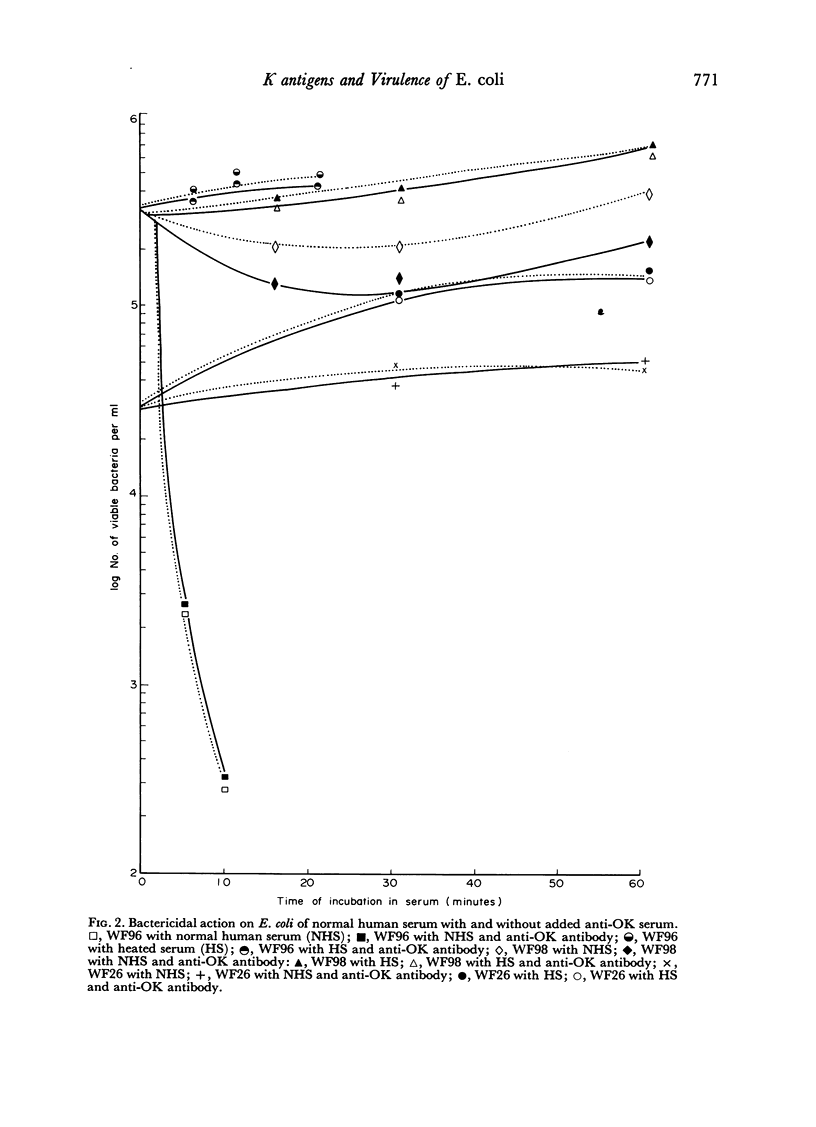
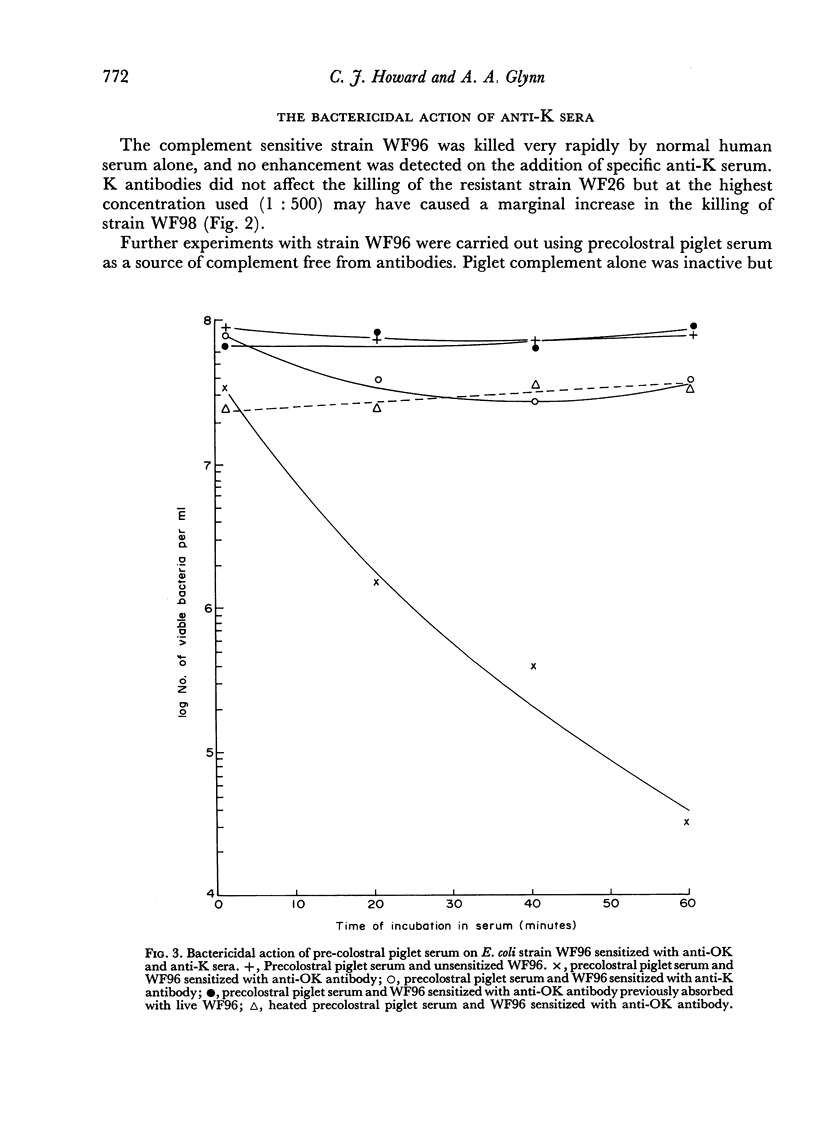
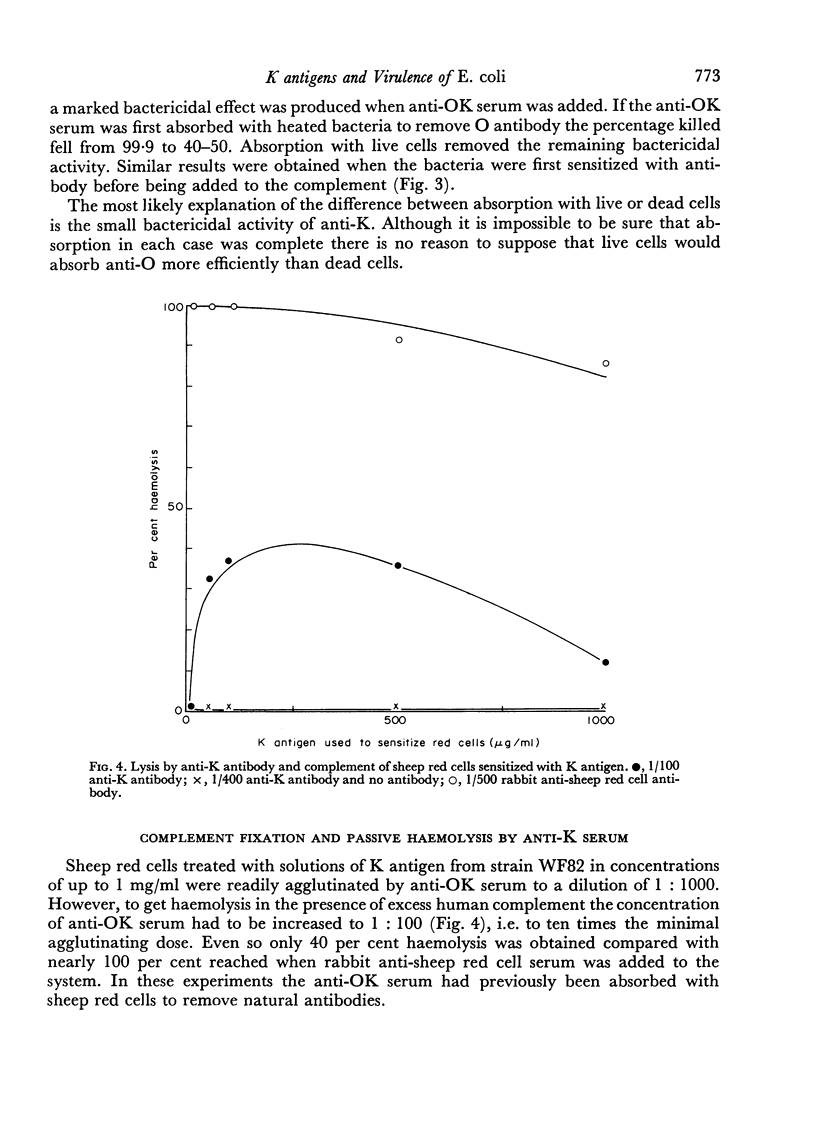
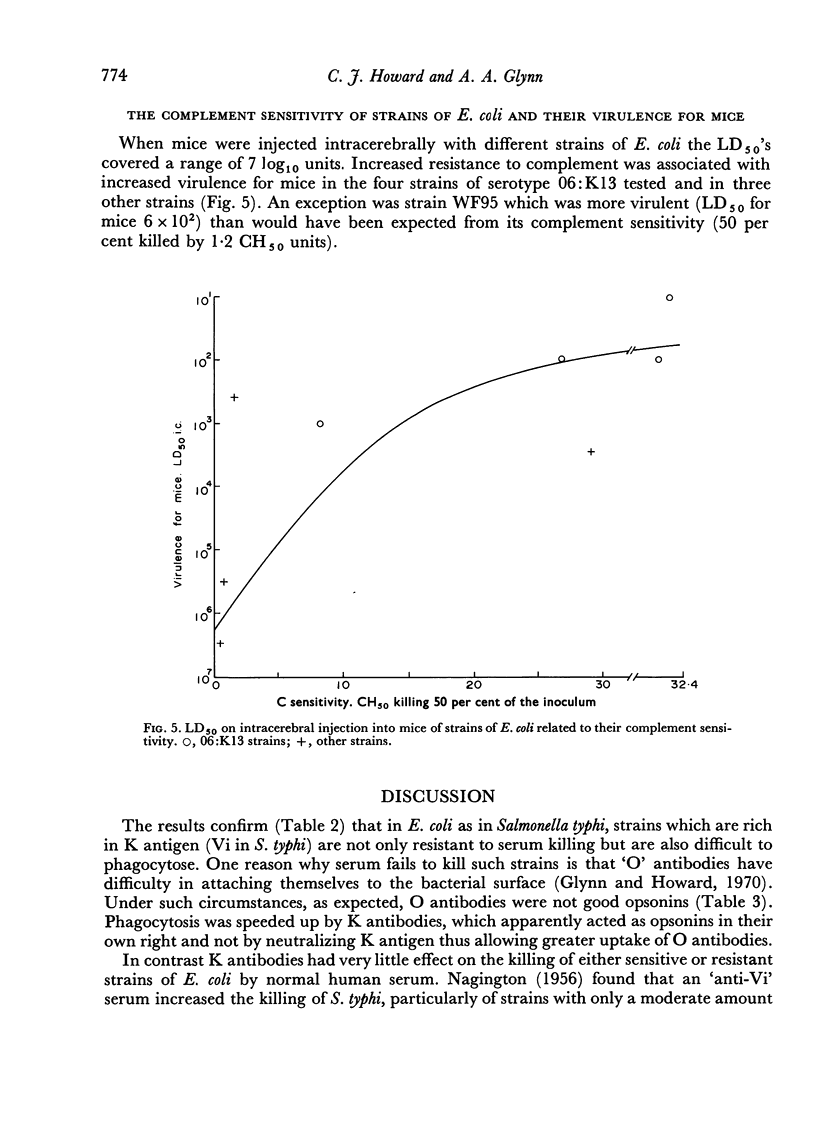
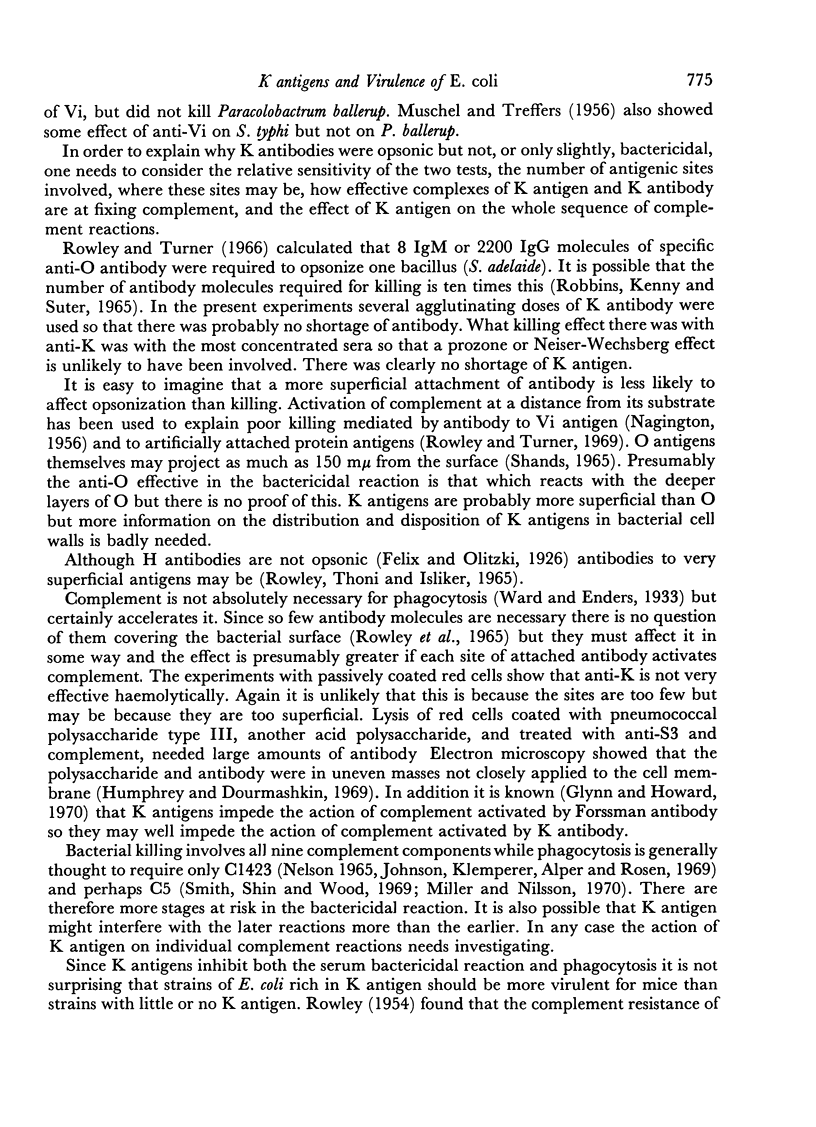
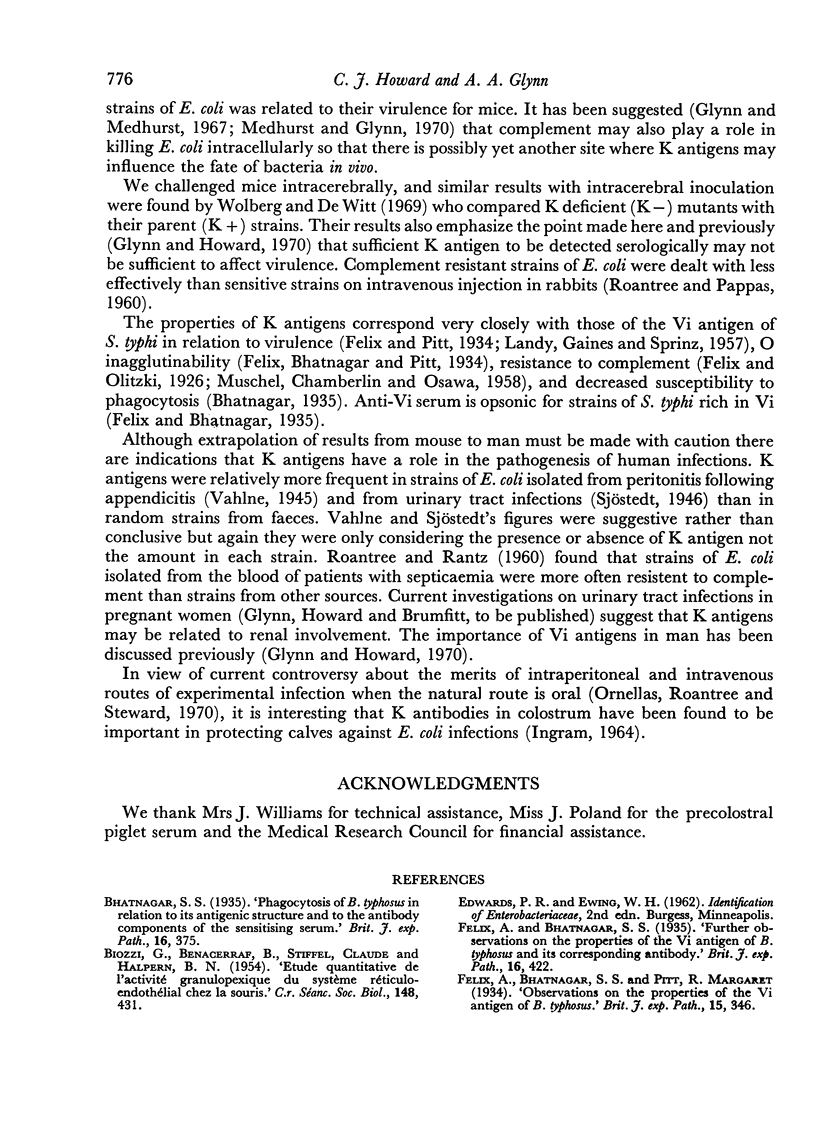
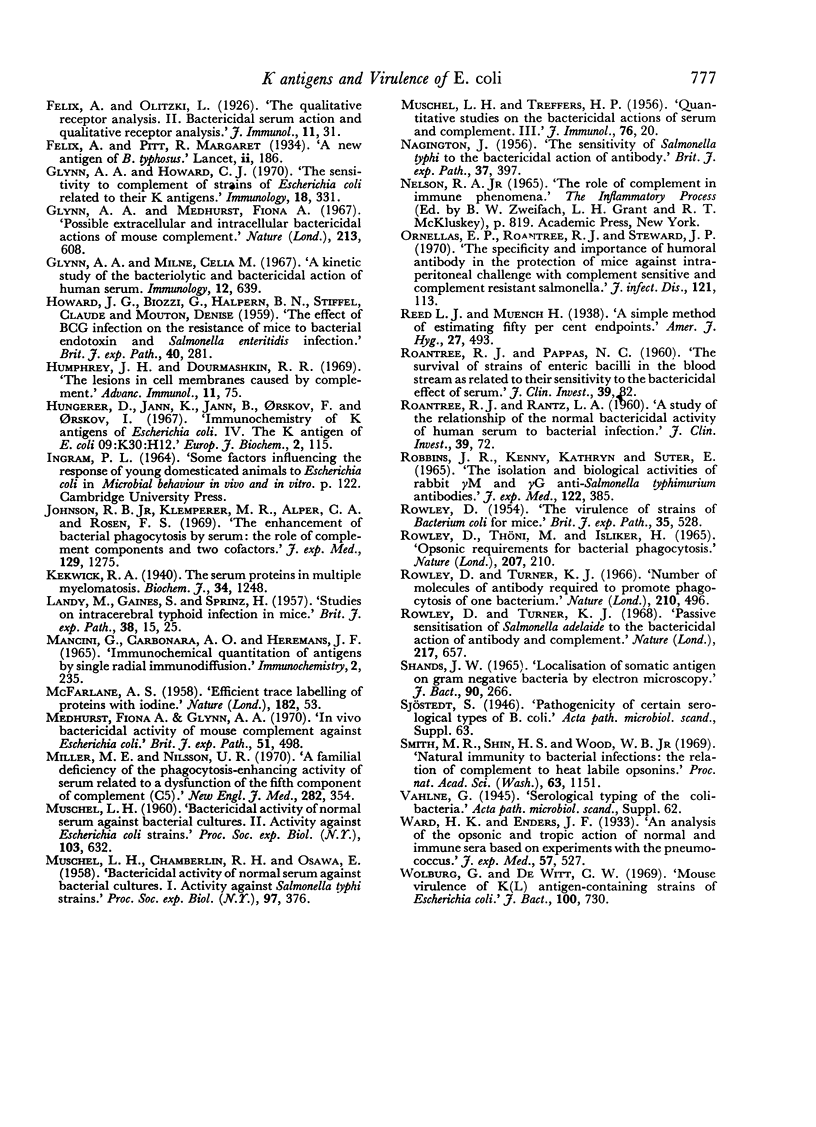
Selected References
These references are in PubMed. This may not be the complete list of references from this article.
- BIOZZI G., BENACERRAF B., STIFFEL C., HALPERN B. N. Etude quantitative de l'activité granulopexique du système réticuloendothéliai chez la souris. C R Seances Soc Biol Fil. 1954 Mar;148(5-6):431–435. [PubMed] [Google Scholar]
- Glynn A. A., Howard C. J. The sensitivity to complement of strains of Escherichia coli related to their K antigens. Immunology. 1970 Mar;18(3):331–346. [PMC free article] [PubMed] [Google Scholar]
- Glynn A. A., Medhurst F. A. Possible extracellular and intracellular bactericidal actions of mouse complement. Nature. 1967 Feb 11;213(5076):608–610. doi: 10.1038/213608a0. [DOI] [PubMed] [Google Scholar]
- Glynn A. A., Milne C. M. A kinetic study of the bacteriolytic and bactericidal action of human serum. Immunology. 1967 Jun;12(6):639–653. [PMC free article] [PubMed] [Google Scholar]
- HOWARD J. G., BIOZZI G., HALPERN B. N., STIFFEL C., MOUTON D. The effect of Mycobacterium tuberculosis (BCG) infection on the resistance of mice to bacterial endotoxin and Salmonella enteritidis infection. Br J Exp Pathol. 1959 Jun;40(3):281–290. [PMC free article] [PubMed] [Google Scholar]
- Humphrey J. H., Dourmashkin R. R. The lesions in cell membranes caused by complement. Adv Immunol. 1969;11:75–115. doi: 10.1016/s0065-2776(08)60478-2. [DOI] [PubMed] [Google Scholar]
- Hungerer D., Jann K., Jann B., Orskov F., Orskov I. Immunochemistry of K antigens of Escherichia coli. 4. The K antigen of E. coli O 9:K30:H12. Eur J Biochem. 1967 Jul;2(1):115–126. doi: 10.1111/j.1432-1033.1967.tb00115.x. [DOI] [PubMed] [Google Scholar]
- Johnston R. B., Jr, Klemperer M. R., Alper C. A., Rosen F. S. The enhancement of bacterial phagocytosis by serum. The role of complement components and two cofactors. J Exp Med. 1969 Jun 1;129(6):1275–1290. doi: 10.1084/jem.129.6.1275. [DOI] [PMC free article] [PubMed] [Google Scholar]
- Kekwick R. A. The serum proteins in multiple myelomatosis. Biochem J. 1940 Sep;34(8-9):1248–1257. doi: 10.1042/bj0341248. [DOI] [PMC free article] [PubMed] [Google Scholar]
- MUSCHEL L. H. Bactericidal activity of normal serum against bacterial cultures. II. Activity against Eschericha coli strains. Proc Soc Exp Biol Med. 1960 Mar;103:632–636. doi: 10.3181/00379727-103-25619. [DOI] [PubMed] [Google Scholar]
- MUSCHEL L. H., CHAMBERLIN R. H., OSAWA E. Bactericidal activity of normal serum against bacterial cultures. I. Activity against Salmonella typhi strains. Proc Soc Exp Biol Med. 1958 Feb;97(2):376–382. doi: 10.3181/00379727-97-23748. [DOI] [PubMed] [Google Scholar]
- MUSCHEL L. H., TREFFERS H. P. Quantitative studies on the bactericidal actions of serum and complement. III. Observations on sera obtained after T.A.B. vaccination or during typhoid fever. J Immunol. 1956 Jan;76(1):20–27. [PubMed] [Google Scholar]
- Mancini G., Carbonara A. O., Heremans J. F. Immunochemical quantitation of antigens by single radial immunodiffusion. Immunochemistry. 1965 Sep;2(3):235–254. doi: 10.1016/0019-2791(65)90004-2. [DOI] [PubMed] [Google Scholar]
- McFARLANE A. S. Efficient trace-labelling of proteins with iodine. Nature. 1958 Jul 5;182(4627):53–53. doi: 10.1038/182053a0. [DOI] [PubMed] [Google Scholar]
- Medhurst F. A., Glynn A. A. In vivo bactericidal activity of mouse complement against Escherichia coli. Br J Exp Pathol. 1970 Oct;51(5):498–506. [PMC free article] [PubMed] [Google Scholar]
- Miller M. E., Nilsson U. R. A familial deficiency of the phagocytosis-enhancing activity of serum related to a dysfunction of the fifth component of complement (C5). N Engl J Med. 1970 Feb 12;282(7):354–358. doi: 10.1056/NEJM197002122820702. [DOI] [PubMed] [Google Scholar]
- NAGINGTON J. The sensitivity of Salmonella typhi to the bactericidal action of antibody. Br J Exp Pathol. 1956 Aug;37(4):397–405. [PMC free article] [PubMed] [Google Scholar]
- Ornellas E. P., Roantree R. J., Steward J. P. The specificity and importance of humoral antibody in the protection of mice against intraperitoneal challenge with complement-sensitive and complement-resistant Salmonella. J Infect Dis. 1970 Feb;121(2):113–123. doi: 10.1093/infdis/121.2.113. [DOI] [PubMed] [Google Scholar]
- ROBBINS J. B., KENNY K., SUTER E. THE ISOLATION AND BIOLOGICAL ACTIVITIES OF RABBIT GAMMA M- AND GAMMA G-ANTI-SALMONELLA TYPHIMURIUM ANTIBODIES. J Exp Med. 1965 Aug 1;122:385–402. doi: 10.1084/jem.122.2.385. [DOI] [PMC free article] [PubMed] [Google Scholar]
- ROWLEY D. The virulence of strains of Bacterium coli for mice. Br J Exp Pathol. 1954 Dec;35(6):528–538. [PMC free article] [PubMed] [Google Scholar]
- Rowley D., Thöni M., Isliker H. Opsonic requirements for bacterial phagocytosis. Nature. 1965 Jul 10;207(993):210–211. doi: 10.1038/207210a0. [DOI] [PubMed] [Google Scholar]
- Rowley D., Turner K. J. Number of molecules of antibody required to promote phagocytosis of one bacterium. Nature. 1966 Apr 30;210(5035):496–498. doi: 10.1038/210496a0. [DOI] [PubMed] [Google Scholar]
- Rowley D., Turner K. J. Passive sensitization of Salmonella adelaide to the bactericidal action of antibody and complement. Nature. 1968 Feb 17;217(5129):657–658. doi: 10.1038/217657a0. [DOI] [PubMed] [Google Scholar]
- Shands J. W. Localization of Somatic Antigen on Gram-Negative Bacteria by Electron Microscopy. J Bacteriol. 1965 Jul;90(1):266–270. doi: 10.1128/jb.90.1.266-270.1965. [DOI] [PMC free article] [PubMed] [Google Scholar]
- Smith M. R., Shin H. S., Wood W. B., Jr Natural immunity to bacterial infections: the relation of complement to heat-labile opsonins. Proc Natl Acad Sci U S A. 1969 Aug;63(4):1151–1156. doi: 10.1073/pnas.63.4.1151. [DOI] [PMC free article] [PubMed] [Google Scholar]


